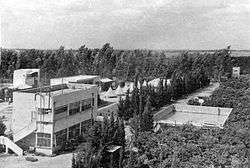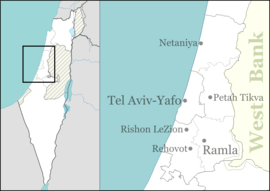Ein HaHoresh
Ein HaHoresh (Hebrew: עֵין הַחוֹרֵשׁ, lit. "the plower's spring" / "the plowman's fountain") is a kibbutz in central Israel. Located to the north of Netanya, it falls under the jurisdiction of Hefer Valley Regional Council. In 2019 it had a population of 836.[1]
Ein HaHoresh עֵין הַחוֹרֵשׁ | |
|---|---|
 Ein Hahoresh, c. 1940 | |
 Ein HaHoresh | |
| Coordinates: 32°23′17.61″N 34°56′25.85″E | |
| Country | Israel |
| District | Central |
| Council | Hefer Valley |
| Affiliation | Kibbutz Movement |
| Founded | 1931 |
| Founded by | Hashomer Hatzair |
| Population (2019)[1] | 836 |
History
It was founded in November 1931 by Hashomer Hatzair members from Eastern Europe who reclaimed the land. It was one of the first settlements in the northern part of the Emek Hefer.[2] The kibbutz was cordoned off and occupied by the British in December 1945 in connection with the struggle for free immigration. It was cordoned off and occupied by the British again in June 1946 along with its neighbor, Givat Haim. As part of the war effort, the kibbutz stepped up its food production.[2] By 1947 the kibbutz had a population of 450.[2]
Economy
The kibbutz developed a successful mixed intensive farm. By 1968 it had 570 inhabitants engaged in intensive farming in citrus plantations, and producing milch cattle. The kibbutz also ran a factory producing sheet steel casks.
Gallery
 Cotton harvesting in Ein Hahoresh, 1980
Cotton harvesting in Ein Hahoresh, 1980
Notable residents
- Abba Kovner (1918–1987), poet, writer and partisan leader
- Amos Meller (1938-2007), composer and conductor
- Benny Morris (born 1948), historian
- Sagol 59 (born Khen Rotem, 1968), rapper, songwriter and guitarist
References
- "Population in the Localities 2019" (XLS). Israel Central Bureau of Statistics. Retrieved 16 August 2020.
- Jewish National Fund (1949). Jewish Villages in Israel. Jerusalem: Hamadpis Liphshitz Press. p. 35.